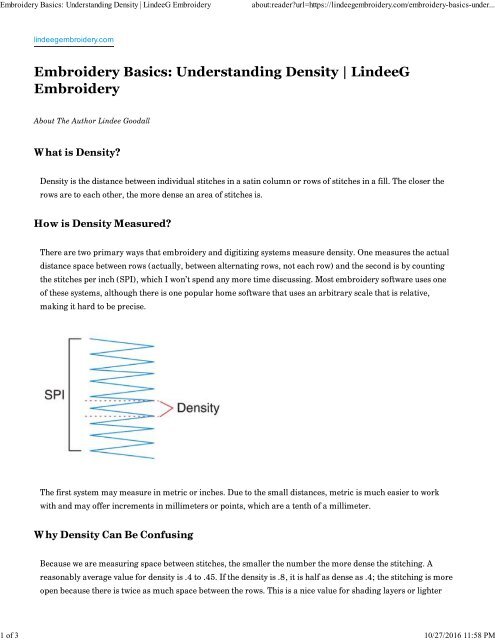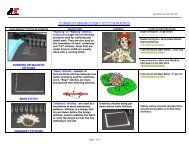Compiled Embroidery Skill Articles
You also want an ePaper? Increase the reach of your titles
YUMPU automatically turns print PDFs into web optimized ePapers that Google loves.
<strong>Embroidery</strong> Basics: Understanding Density | LindeeG <strong>Embroidery</strong><br />
about:reader?url=https://lindeegembroidery.com/embroidery-basics-under...<br />
1 of 3 10/27/2016 11:58 PM<br />
lindeegembroidery.com<br />
About The Author Lindee Goodall<br />
What is Density?<br />
Density is the distance between individual stitches in a satin column or rows of stitches in a fill. The closer the<br />
rows are to each other, the more dense an area of stitches is.<br />
How is Density Measured?<br />
There are two primary ways that embroidery and digitizing systems measure density. One measures the actual<br />
distance space between rows (actually, between alternating rows, not each row) and the second is by counting<br />
the stitches per inch (SPI), which I won’t spend any more time discussing. Most embroidery software uses one<br />
of these systems, although there is one popular home software that uses an arbitrary scale that is relative,<br />
making it hard to be precise.<br />
The first system may measure in metric or inches. Due to the small distances, metric is much easier to work<br />
with and may offer increments in millimeters or points, which are a tenth of a millimeter.<br />
Why Density Can Be Confusing<br />
Because we are measuring space between stitches, the smaller the number the more dense the stitching. A<br />
reasonably average value for density is .4 to .45. If the density is .8, it is half as dense as .4; the stitching is more<br />
open because there is twice as much space between the rows. This is a nice value for shading layers or lighter




